
Books on Happiness / The Definitive Book Of Body Language- 2 students
.pdf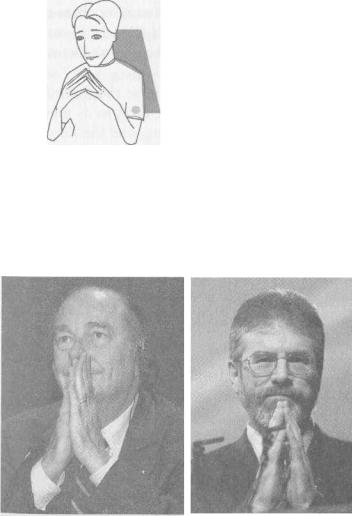
Hand and Thumb Gestures
form a church steeple and will sometimes rock back and forth like a spider doing push-ups on a mirror.
We found that the Steeple was frequently used in superiorsubordinate interaction and that it indicates a confident or self-assured attitude. Superiors often use this gesture position when they give instructions or advice to subordinates and it is particularly common among accountants, lawyers and managers. People who are confident, superior types often use this gesture and, by doing so, signal their confident attitude.
Confident he has the right answers
Those who use this gesture sometimes convert the Steeple into a praying gesture in an attempt to appear God-like. As a general rule, the Steeple should be avoided when you want to be persuasive or win the other person's confidence, as it can sometimes be read as smugness or arrogance.
President Chirac and Gerry Adams sometimes appear God-like
133
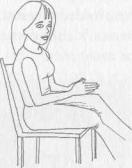
The Definitive Book of Body Language
If you want to look as if you are confident and have all the right answers, the Steeple position will do it for you.
Using Steepling to Win at Chess
Picture this scene - you're playing chess and it's your turn to move. You move your hand over the chessboard and rest your finger on a chess piece, indicating you intend to move that piece. You then notice your opponent sit back and make the Steeple gesture. Your opponent has just told you, non-verbally, that he feels confident about your move so your best strategy is not to make it. You next touch another chess piece and see your opponent assume the Hands Clenched gesture or Arms Crossed position, signalling that he doesn't like your potential move — so you should make it.
The Steeple has two main versions: the Raised Steeple, the position often assumed when the Steepler is giving his opinions or ideas or is doing the talking; and the Lowered Steeple, which is normally used when the Steepler is listening rather than speaking.
The Lowered Steeple
Women tend to use the Lowered Steeple position more often than the Raised Steeple. When the Raised Steeple is taken with the head tilted back, the person takes on an air of smugness or arrogance.
Although the Steeple gesture is a positive signal, it can be used in either positive or negative circumstances and may be misinterpreted. For example, let's say you are presenting an idea to someone and have seen them using several
134

Hand and Thumb Gestures
positive gestures during the presentation, such as open palms, leaning forward, head up, nodding and so on. Let's say that towards the end of your presentation the other person begins to Steeple.
If the Steeple follows a series of other positive gestures and appears when you show the other person the solution to his problem, it's likely you've been given the go-ahead to 'ask for the order'. On the other hand, if the Steeple gesture follows a series of negative gestures such as arm folding, leg crossing, looking away and hand-to-face gestures, he may be confident that he won't say 'yes' or that he can get rid of you. In both these cases the Steeple registers confidence, but one has positive results and the other negative consequences. The gestures preceding the Steeple are the key to the outcome.
Summary
Your hands are always in front of you, revealing your emotions and attitudes. Many body language gestures can be difficult to learn but hand gestures can be practised and rehearsed to a point where you can have fairly good control over where your hands are and what they are doing. When you learn to read hand gestures you'll look more confident, feel more successful and win more chess games.
The Face Platter
The Face Platter - Presenting her face for a man to admire
This is not a negative gesture - it's a positive one used in courtship. It's used mainly by women and by gay men who want to attract a man's attention. A woman will place one hand on top of the other and present her face to a man as if it was on a platter for him to admire.
135
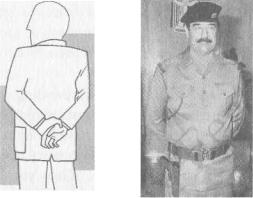
The Definitive Book of Body Language
If you are going to use flattery - sincere or not - this gesture gives the green light for it.
Holding Hands Behind the Back
The Duke of Edinburgh and several other male members of the British Royal Family are noted for their habit of walking with head up, chin out and one hand holding the other hand behind the back. This gesture is common among leaders and royalty and is used by the policemen patrolling the beat, the headmaster walking around the school playground, senior military personnel and anyone in a position of authority.
Back and front views of the superiority-confidence gesture
The emotions attached to this gesture are superiority, confidence and power. The person exposes their vulnerable stomach, heart, crotch and throat in a subconscious act of fearlessness. Our experience shows that, if you take this position when you are in a high-stress situation, such as being interviewed by newspaper reporters or waiting outside a dentist's surgery, you'll begin to feel confident and even authoritative, as a result of cause and effect.
Our work with law enforcement officers showed that offi-
136

Hand and Thumb Gestures
cers who don't wear firearms use this position regularly and often rock back and forth on the balls of the feet when standing to gain additional height. Police officers who wear firearms seldom use this gesture, preferring to let their arms hang by their side or to have their thumbs tucked into the belt. The firearm gives the officer sufficient power that Palm-in-Palm behind the back is not a necessary display of authority.
The Hand-Gripping-Wrist gesture communicates a different emotion to Palm-in-Palm behind the back. It's a signal of frustration and an attempt at self-control. One hand grips the other wrist or arm tightly behind the back, as if in an attempt by one arm to prevent the other from striking out.
The Hand-Gripping-Wrist gesture
The higher up one hand grips the opposite arm, the more frustrated or angry the person is likely to be. In the illustration below the person is showing a greater attempt at self-control than in the previous picture, because the hand is gripping the upper arm, not just the wrist. This gesture shows the origin of the expression, 'Get a good grip on yourself.'
The Upper Arm Grip
137
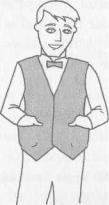
The Definitive Book of Body Language
Wrist-and-arm-gripping behind the back can often be observed outside a courtroom when warring parties are face to face, in salespeople standing in a customer's reception area and in patients waiting for a doctor. It's an attempt to disguise nervousness or self-restraint and, if you catch yourself doing it, change to the Palm-in-Palm behind the back and you will begin to feel more confident and in control.
Thumb Displays
As mentioned earlier, thumbs denote superiority. In palmistry, the thumbs represent strength of character and the ego, and body language signals involving the thumbs also show selfimportant attitudes. Thumbs are used to display dominance, assertiveness or sometimes aggressive attitudes; thumb gestures are secondary gestures and are usually part of a cluster. Thumb displays are positive signals, often used in the typical pose of the 'cool' individual who uses them to show superiority. A man will use Protruding Thumbs around women to whom he is attracted and people who wear high-status or prestige clothing also display their thumbs. You will rarely see a low-status individual, such as a vagrant, doing it.
The Waistcoat Thruster
Thumb displayers also often rock on the balls of their feet to give the impression of extra height.
38

Hand and Thumb Gestures
fhumbs-Protruding-from-Coat-Pocket
This gesture is common to men and women who feel they are in a superior position to others. It's one of Prince Charles' regular gestures and reveals the incontrol attitude he feels at the time. In a work environment, the boss will walk around the office in the position and, when the boss is away, the person who is next in charge will walk around using it. But none of the subordinates would dare to use it in front of the boss.
Thumb displays can become obvious when a person gives a contradic-
tory verbal message. Take, for example, the lawyer who turns to the jury and in a soft, low voice says, 'In my humble opinion, ladies and gentlemen ...' while displaying his thumbs and tilting back his head to 'look down his nose' at them.
A lawyer pretending to be humble
139
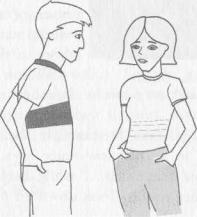
The Definitive Book of Body Language
This can make the jury feel that the lawyer is being insincere or pompous. If a lawyer wanted to appear humble, he should approach the jury with his coat open, with open palms and stoop forward to appear smaller.
'You seem like an intelligent, honest man,' the lawyer said smugly. 'I'd return the compliment, sir,' said the witness. 'But I'm under oath.'
Thumbs sometimes protrude from the back pockets (see below) as if the person is trying to hide their dominant attitude. Women were rarely seen using Thumb Displays until the 1960s when they began to wear trousers and take on more authoritative roles in society.
Thumb displays revealing confident, authoritative attitudes
Arms-Folded-with-Thumbs-Pointing-Upwards is another common thumb cluster. This is a double signal, showing a defensive or negative attitude (folded arms), plus a superior attitude revealed by the thumbs. The person using this cluster usually gestures with his thumbs when he talks, and rocks on the balls of his feet when standing.
40

Hand and Thumb Gestures
Closing himself off
but still feeling superior
The thumb can also be used as a signal of ridicule or disrespect when it is used to point at another person. For example, the husband who leans across to his friend, points towards his wife with his thumb and says 'She always nags', is inviting an argument with her. In this case, the shaking thumb is used as a pointer to ridicule her. Consequently, thumb-pointing is irritating to most women, particularly when a man does it. The Thumb Shaking gesture is not common among women, although they sometimes use the gesture to point at people they don't like.
'She always nags me!'
Summary
Ihe thumbs have been used as a sign of power and authority for thousands of years. In Roman times, the thumb held up or down meant life or death to a gladiator. Even without any training, others intuitively decode thumb signals and seem to understand their meaning. You are now in a position not only to decode thumb signs, but to train yourself to use them.
141
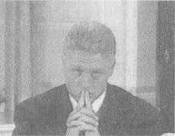
Chapter 7
EVALUATION AND
DECEIT SIGNALS
Decoding Hand-to-Face Gestures
Bill Clinton in front of the Grand Jury - what do you think he's thinking?
If you told the absolute truth to everyone you interacted with, what would be the result? If you said the exact words going through your mind as you thought them, what consequences would it bring? For example:
To your boss: 'Good morning, boss — you talentless slob.'
Man to a female customer: 'Thanks for your business, Susan, and may I say what wonderful firm breasts you have.'
Woman to a male neighbour: 'Thanks for helping me with my groceries. You've got a nice tight butt but who the hell cuts your hair?'
To your mother-in-law: 'It's nice to see you again — you, interfering, negative old bat.'
When a woman asks, 'Does this dress make me look fat?' what is your answer? If you are a man, and you know what's good for you, you'd say she looked good. But you might have been thinking, 'The dress doesn't make you look fat - it's all the
142
